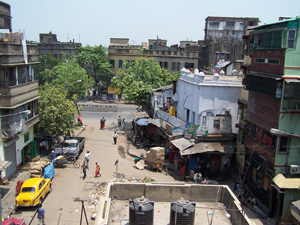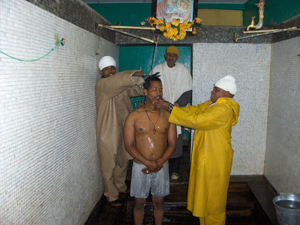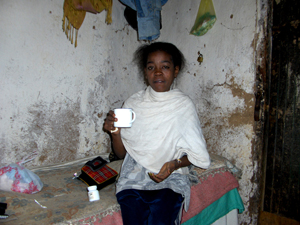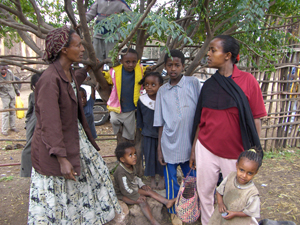KOLKATA, India — In Sonagachi, a district of the Indian city of Kolkata (Calcutta), children play cricket in the middle of an unpaved road, while men bathe under a pumping well and a group of veiled women sing a Bengali hymn as they walk to worship at an outdoor temple honoring the goddess Kali. Neither the street scene nor the jumble of high-rise commercial buildings and tailor shops nearby gives any indication that Sonagachi is one of the biggest red-light districts in India, home to an estimated 9,000 sex workers.
Instead, to glimpse the hidden world of Indian commercial sex, it’s necessary to step through a narrow doorway, over which a small statue of the Hindu god Ganesha stands watch, and enter a tiny room with a barred window. It’s the home of Madhu, 25, whose looks and age qualify her as an “A” category sex worker, capable of earning 1,000 rupees — the equivalent of $22 in U.S. currency — for each sex act.
As her 4-year-old daughter played with her mother’s long, curly hair, Madhu was asked in an interview whether she would allow her little girl to follow in her footsteps. The answer was an emphatic no. “I want my daughter to be educated,” she said. “I’ve ruined my life. If she does the same, no one will marry her, and she won’t have anyone to share her life with.” And to guarantee that Madhu will be around to help her daughter achieve that dream, the sex worker is adamant about one other thing — that all her clients take precautions to protect her against becoming infected with HIV. “I tell them no sex without condoms,” she said.
The resolve of women such as Madhu is vital to India’s future. The second-most populous nation on Earth with more than 1.1 billion inhabitants, India has an HIV/AIDS prevalence rate for ages 15-49 of 0.9 percent, which is much lower than the epidemic’s African hot spots. Yet some experts fear that India could fall victim to the next big wave of the epidemic, if the disease begins to spread from the nation’s vast, largely underground sex-worker industry — where the infection rate is much higher — to the general population.
‘Loyalty oath’ against prostitution imperils funding
In response to India’s potential peril, the President’s Emergency Plan for AIDS Relief (PEPFAR), the Bush administration’s five-year, $15 billion effort to fight HIV/AIDS, is spending $29.3 million in 2006. But PEPFAR’s effectiveness in India may be hindered by the U.S. government’s insistence that HIV/AIDS organizations pledge in PEPFAR’s “anti-prostitution loyalty oath” explicitly to oppose prostitution before they can receive funding.
That requirement blocks any U.S. money from flowing to grass-roots HIV/AIDS organizations in Sonagachi and elsewhere that have enlisted India’s sex workers themselves in the effort to spread information about HIV/AIDS and promote safe sex practices in the sex trade. As a result, the U.S. may be squandering a critical opportunity to help prevent the spread of HIV/AIDS in India.
Rekha Masilamani, India’s representative at Pathfinder International, a nongovernmental organization (NGO) whose funding would be bound by the anti-prostitution policy, told ICIJ that no one in the field “wants prostitution to survive.”
“But it’s a reality,” she said, “and it has been around since man began, and will be for a long time to come. … The oath paralyzes people, makes those working in the field being unsure of what they can or can’t do.”
The HIV/AIDS epidemic and its connection to commercial sex is something of a taboo subject in India, because prostitution is both illegal and strongly condemned by traditional Indian morality. But beneath that societal facade of disapproval, India harbors one of the biggest and fastest-growing sex trades on the planet. According to a recent study commissioned by the Indian government, the number of sex workers in India has increased by 50 percent, to 3 million, in less than a decade.
The Indian sex industry threatens to become a launching pad for a second, larger wave of the HIV/AIDS epidemic in India. Official government estimates put the HIV infection rate among Indian sex workers at 8.4 percent — about nine times the rate among the general population. That would mean that more than 250,000 Indian sex workers are HIV-positive. And there are indications that the actual incidence of HIV/AIDS in the Indian sex industry is even higher. According to UNAIDS, the Joint United Nations Program on HIV/AIDS, 50 percent of sex workers in urban southern India are infected, and a recent Scientific American article put the infection rate in the brothels of Mumbai (Bombay) at 60 percent.
Too few sex workers are taking precautions that might save their lives — and those of their customers. A study published in the Journal of Communicable Diseases in 2003, for example, found that only half of Indian sex workers in Kolkata even knew that condom use could help protect them from becoming infected with HIV.
A 2005 U.N. report theorized that in India, the epidemic already is following a pattern in which sex workers and other high-risk groups are infecting “bridge populations” — i.e., sex workers’ male clients — who then spread the disease into the general population.
But while a PEPFAR document acknowledges that sex work is “a driving factor of the epidemic” in India, relatively little of the U.S.-funded HIV/AIDS prevention effort seems to be directed at the sex industry. U.S. Agency for International Development (USAID) money does underwrite a chain of “Operation Lighthouse” clinics operated by Population Services International, a U.S.-based NGO, where sex workers and their clients can be tested for HIV and offered counseling. PEPFAR is funding the creation of drop-in centers along a heavily traveled highway, at which truck drivers — a group that often patronizes brothels — can receive information about HIV prevention “between socializing and games of caroms,” an Indian board game. Another PEPFAR-supported program inserted prevention messages in lunches delivered to office workers in Mumbai on World AIDS Day in 2005.
PEPFAR also funds prevention efforts by groups such as Catholic Relief Services, which promotes abstinence and faithfulness within marriage, and attempts to educate girls in villages about life choices they can make instead of becoming sex workers. However, Marc D’Silva, CRS country representative for India, admitted that “our organization is not the best place to deal with certain groups” — i.e., sex workers.
Empowering women to demand safe sex
But while PEPFAR doesn’t appear to have made major inroads in the Indian sex industry, Indian sex workers themselves have taken an active role in preventing the spread of HIV/AIDS. In Sonagachi, the brothel district where Madhu and thousands of other sex workers live and work, the HIV infection rate is just 5 percent — much lower than other parts of the Indian sex industry. That largely is due to the efforts of the Durbar Mahila Samanwaya Committee, whose name roughly translates as “Indomitable Women’s Solidarity Committee.”
DMSC, which does not receive U.S. government funding, has 65,000 members in Sonagachi and other West Bengal brothel districts. It essentially functions as a professional guild and benevolent association for sex workers. The organization was founded in the early 1990s by Smarajit Jana, a public health scientist assigned by the World Health Organization to survey Sonagachi’s brothels for HIV.
After finishing his research, Jana continued to work with local sex workers, training a few of them so that they could go around to brothels and educate other sex workers about HIV. Jana quickly learned that sex workers were reluctant to ask customers to use condoms, because the men simply would find someone who didn’t insist upon it. As a solution, he encouraged sex workers to band together into a unified front, so that they would have more power to enforce safe sex practices.
Jana told ICIJ that empowering and enabling the women is vital to protecting them against HIV/AIDS. “How many women in this gender-dominated country have a choice? … We want to reach those least powerful and vulnerable.” His community-led project helps sex workers gain a level of confidence and trust to be able to spread the message of safe sex to each other and their clients.
Bharati Dey, a former sex worker who now serves as DMSC’s program director, told ICIJ that as a result of the organization’s efforts, 85 percent of Sonagachi’s sex workers now use condoms. “We are educating their clientele also, so that the customers tell their friends about STDs,” she said. “We even take their wives to the clinic.”
Over the years, DMSC has expanded its role. In addition to educating sex workers to see HIV/AIDS as an occupational hazard and distributing condoms to them and their customers at 49 brothels in West Bengal, the organization has created a credit union where sex workers can build up their savings and obtain small loans to go into other businesses besides sex work. The organization uses its network of woman members to monitor the brothels for sexual exploitation of children and then reports cases to the police. “We have rescued 380 minor girls,” Dey said. “Some of them went back home, and some to the welfare centers.” DMSC founder Jana, who now works with CARE in Delhi, explained: “Everyone is against sex trafficking. It’s a misnomer to equate it with sex work.”
Going beyond the sex industry
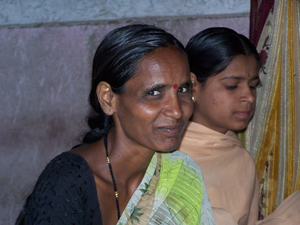
Elsewhere in India, sex workers themselves are not only leading HIV/AIDS education and prevention efforts, but also providing help to other HIV-positive Indians. In the town of Sangli, about 200 miles southeast of Mumbai, a support group of rural women meets in a small classroom. The participants range in age from 20-somethings to grandmotherly types in their 60s, but group leader Sushila Kunde explains that they all have something in common — they’re either HIV-positive or have a family member who is.
The gathering is part of a program run by SANGRAM, another organization involved with Indian sex workers. Among other assistance, SANGRAM provides the HIV-positive women in the group with bus fare so that they can get to the public hospital where they receive antiretroviral drug therapy, which has been credited with transforming HIV/AIDS from a fatal condition to a manageable illness.
Like DMSC, SANGRAM enables sex workers to unify in enforcing safe sex practices in brothels. The organization distributes 350,000 free condoms each month.
SANGRAM’s HIV/AIDS prevention efforts extend beyond the sex industry. For example, since the 1990s the organization has a program that recruits local women who are not sex workers to play the role of maitrin (“girlfriend”) to other women in their villages. The maitrins use their neighborly intimacy to pass along information about HIV/AIDS and how women can protect themselves from infection. In addition, the maitrins work to organize their friends to provide economic and other support to HIV-positive women in the village.
Though the HIV/AIDS prevention efforts of organizations such as DMSC and SANGRAM have attracted international acclaim and support from philanthropic institutions such as the Ford Foundation, they might be able to expand their efforts even further if they were to receive an infusion of funding from PEPFAR. But that isn’t happening, because in 2003, Congress passed a law requiring all recipients of U.S. funding for HIV/AIDS work to have a policy of “explicitly opposing prostitution and sex trafficking.”
The law also requires any foreign or non-U.S. nongovernmental organization to sign what critics have called the “anti-prostitution loyalty oath” — an agreement in which the organizations must state that they do not promote the legalization or practice of prostitution and that they will ensure that any subcontractors take the same stance. Organizations have to apply the anti-prostitution policy to all of their work, even programs that are funded by private donors.
Originally the policy was meant to be applied to any organization using funds allocated through the act. However, in August and September of 2005 lawsuits alleging that the oath violated the First Amendment and its application to U.S.-based organizations were filed in New York by two U.S. organizations, the Alliance for Open Society International and Pathfinder International, and in Washington, D.C., by DKT International, whose funding was subject to the policy.
In May 2006, federal judges in both cities ruled that the anti-prostitution pledge violated the First Amendment rights of U.S.-based organizations. But the ruling didn’t have any impact on the restrictions for foreign-based organizations.
USAID did not respond to ICIJ inquiries about the policy, but in a 2005 Associated Press interview, USAID official Kent Hill defended the policy as a way for the U.S. to take a stand against the international sex trade. “Prostitution is not a positive for the people who are involved in it,” Hill said. “The vast majority of people, globally, do not find themselves there by choice.”
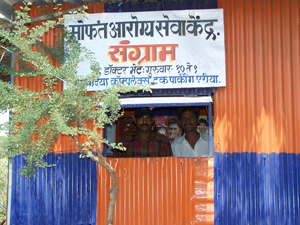
SANGRAM actually once was a recipient of U.S funding. But in 2005, the organization clashed with a U.S.-based religious group that accused it of trying to protect brothel owners who trafficked in minor girls — an allegation SANGRAM has vigorously denied. SANGRAM’s U.S. grant was ended “by mutual consent” of the U.S. and SANGRAM, according to letter to SANGRAM director Seshu from U.S. Embassy spokesman David Kennedy. (“United States Government funding was not removed from SANGRAM for trafficking in persons,” Kennedy wrote.)
Seshu said that her organization decided to return $4,000 that had been paid out of a $12,000 U.S. grant, rather than sign a required pledge that it opposed prostitution. The money was to have underwritten SANGRAM’s condom distribution efforts.
“The anti-prostitution policy makes no sense at all,” said Seshu, the 2002 recipient of an award from Human Rights Watch for her HIV/AIDS prevention efforts. “What is the end result we are looking for? That people don’t die,” she told ICIJ in a recent interview. “Ours is a rights-based approach. These women can be change agents.”
The U.S. policy of not working with activists in the sex industry is at odds with the U.N., which issued a 2005 report that recommended involving sex workers in prevention efforts. Dr. Denis Broun, the UNAIDS India country coordinator, said that the U.S. policy “will not solve the problem. There has and always will be prostitution. We have to choose methods of AIDS control that have proven efficacy.”
The U.S. anti-prostitution stance also clashes with the position of the Indian government’s own National AIDS Control Organization, which in 1999 set a goal of getting 90 percent of sex workers and other high-risk groups to use condoms by 2006. NACO director Sujatha Rao says the Indian policy favors “empowering sex workers with knowledge, information and access to services.”
“The NACO program is solidly based on prevention by focusing on the highly vulnerable populations,” Rao said. “NACO is only concerned with the health of every citizen of India, whether a sex worker or not.”
Meanwhile, SANGRAM continues working to educate sex workers and their customers about HIV/AIDS and how to avoid becoming infected. Along Katras Road, the main truck route through Sangli, SANGRAM activists Praful Jamkhande and Vitthal Javir, who are relatives of sex workers, sit in a small metal kiosk that stands between the trucks painted in the brilliant green, orange and white hues of the Indian flag. The interior is lined with HIV/AIDS awareness posters and there are stacks of informational pamphlets, but because some of the truck drivers who stop by are illiterate, Jamkhande and Javir are there to convey the information verbally as well. Once a week, a physician comes to give exams for sexually transmitted diseases, and boxes of free condoms are offered for the taking.
“When we were beginning, people didn’t know [about HIV] and didn’t want to understand,” Jamkhande said. “But now, they know who we are and what we do, and they’re coming to us.”
